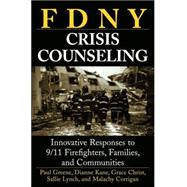
Note: Supplemental materials are not guaranteed with Rental or Used book purchases.
Purchase Benefits
What is included with this book?
DIANNE KANE, DSW, CGP, is Assistant Director of the FDNY Counseling Services Unit, and an adjunct Associate Professor at Hunter College School of Social Work.
GRACE CHRIST, DSW, is Associate Professor at the Columbia University School of Social Work, Director of the Social Work Leadership Development Awards Program of the Project on Death in America, and Director of the FDNY/Columbia University Family Assessment and Guidance Program.
SALLIE LYNCH, MA, is a cultural anthropologist, and was the program coordinator of the FDNY/Columbia University Family Assessment and Guidance Program.
MALACHY CORRIGAN, MA, RN, has been the Director of the FDNY Counseling Services Unit since 1982.
| Preface | xiii | ||||
| Acknowledgments | xix | ||||
| Chapter 1 Introduction | 1 | (9) | |||
| Chapter 2 Coping with Chaos | 10 | (23) | |||
|
11 | (5) | |||
|
16 | (2) | |||
|
18 | (3) | |||
|
21 | (2) | |||
|
23 | (1) | |||
|
23 | (1) | |||
|
24 | (2) | |||
|
26 | (3) | |||
|
29 | (1) | |||
|
30 | (3) | |||
| Chapter 3 Understanding Culture | 33 | (35) | |||
|
35 | (2) | |||
|
37 | (2) | |||
|
39 | (6) | |||
|
45 | (2) | |||
|
47 | (1) | |||
|
48 | (2) | |||
|
50 | (4) | |||
|
54 | (2) | |||
|
56 | (4) | |||
|
60 | (3) | |||
|
63 | (5) | |||
| Chapter 4 Shaping Services to Meet Emerging Needs | 68 | (30) | |||
|
69 | (5) | |||
|
74 | (5) | |||
|
79 | (3) | |||
|
82 | (1) | |||
|
83 | (4) | |||
|
87 | (3) | |||
|
90 | (5) | |||
|
95 | (1) | |||
|
96 | (2) | |||
| Chapter 5 Providing Help in the Workplace: The Firehouse Clinician Project | 98 | (38) | |||
|
98 | (2) | |||
|
100 | (3) | |||
|
103 | (3) | |||
|
106 | (1) | |||
|
107 | (4) | |||
|
111 | (4) | |||
|
115 | (5) | |||
|
120 | (5) | |||
|
125 | (9) | |||
|
134 | (2) | |||
| Chapter 6 Modifying Psychotherapy for Individuals | 136 | (18) | |||
|
136 | (4) | |||
|
140 | (3) | |||
|
143 | (6) | |||
|
149 | (4) | |||
|
153 | (1) | |||
| Chapter 7 Finding Comfort in Groups | 154 | (26) | |||
|
155 | (1) | |||
|
156 | (1) | |||
|
156 | (3) | |||
|
159 | (3) | |||
|
162 | (2) | |||
|
164 | (1) | |||
|
165 | (11) | |||
|
176 | (2) | |||
|
178 | (2) | |||
| Chapter 8 Providing a Home-Based Therapeutic Program for Widows and Children | 180 | (32) | |||
|
181 | (6) | |||
|
187 | (2) | |||
|
189 | (2) | |||
|
191 | (5) | |||
|
196 | (2) | |||
|
198 | (1) | |||
|
199 | (1) | |||
|
199 | (8) | |||
|
207 | (5) | |||
| Chapter 9 Strengthening Connections within the Family at Home | 212 | (19) | |||
|
215 | (2) | |||
|
217 | (2) | |||
|
219 | (1) | |||
|
220 | (8) | |||
|
228 | (3) | |||
| Chapter 10 Assisting Retirees in Transition | 231 | (15) | |||
|
231 | (3) | |||
|
234 | (2) | |||
|
236 | (7) | |||
|
243 | (3) | |||
| Chapter 11 Conclusion | 246 | (11) | |||
|
248 | (1) | |||
|
249 | (1) | |||
|
250 | (1) | |||
|
251 | (2) | |||
|
253 | (2) | |||
|
255 | (2) | |||
| Postscript | 257 | (2) | |||
| References | 259 | (6) | |||
| Index | 265 |
The New copy of this book will include any supplemental materials advertised. Please check the title of the book to determine if it should include any access cards, study guides, lab manuals, CDs, etc.
The Used, Rental and eBook copies of this book are not guaranteed to include any supplemental materials. Typically, only the book itself is included. This is true even if the title states it includes any access cards, study guides, lab manuals, CDs, etc.